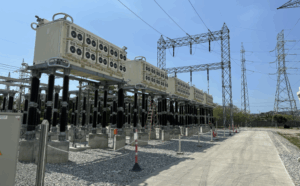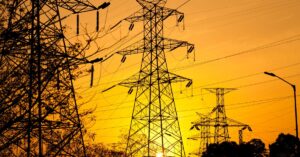
Utilizing New Transmission Lines with Advanced Power Flow Control
December 2, 2024
New transmission lines are essential to the energy transition, however often they can’t be utilized fully due to congestion in the surrounding network. In this article, Paul Harrington explains how advanced power flow control solutions enable utilities to manage this congestion and enable optimal use of new lines before and after they are commissioned.

The advanced power flow control solutions provided by technologies such as SmartValve™ allow the re-routing of power flow amongst nearby lines by increasing or decreasing the apparent series reactance of a transmission line to ‘push’ or ‘pull’ power off or onto the line. This improves the overall capability of the transmission system without needing to build new lines by balancing flows more evenly between the existing circuits. However, we are now seeing an increase in the prevalence of opportunities to use advanced power flow control to improve the benefits provided by new transmission line builds as utilities strive to integrate greater levels of renewable generation into the grid. In this post, we’ll explore this topic further, using examples of development scenarios that are becoming increasingly commonplace around the world.
As fossil-fueled power plants are progressively retired and replaced by renewable generation, the grid is being stretched to manage power flows that are very different from those it was planned around. The reasons for this are two-fold.
Firstly, newly built renewable generation is often not in the same geographical area as the retiring thermal power plants it is replacing due to the renewable energy resources, such as wind and solar, being in different locations than the coal or gas supplies used to fuel the legacy generators. Significant quantities of renewable generation are, therefore, being connected to areas of the grid that have not been designed to carry such large amounts of power. This necessitates the construction of new intra-regional transmission lines parallel to the existing grid to allow the renewable energy zones (REZs) to be developed to their full potential.
Secondly, the intermittent nature of renewable energy resources requires not only a greater amount of renewable generation to be built but also a grid capable of sharing this generation amongst different regions to provide geographical diversity as wind and solar availability vary in time between regions. This necessitates the construction of additional inter-regional transmission capacity, typically in conjunction with existing lines, to provide the increase in power transfer required to maintain a reliable renewable energy supply.
In today’s world, it can be very challenging to build new lines in most countries due to lengthy permitting, public opposition, availability of land, and the very large capital expenditure required. This means that new lines are typically built as high-capacity circuits with larger conductors to achieve maximum gain from the line easement. However, full utilisation of the new line’s capacity is often not possible due to congestion that occurs on existing lower-rated lines. Advanced power flow control solutions, such as SmartValve, can overcome this issue by allowing the system operator to dynamically control power flows on the surrounding circuits and enable more power to flow down the new transmission lines. This helps ensure optimal use of new infrastructure and thus improves the return on investment of the new line.
As described, the addition of high-capacity transmission lines to the grid is occurring more frequently to allow the connection of large quantities of renewable generation to the grid and also to allow the transfer of this power between neighboring regions. In both cases, existing low-rated lines will often thermally constrain, resulting in the underutilization of the newly constructed lines. The system planner is presented with two opportunities to relieve this constraint with advanced power flow control equipment. Either, the loading of the constrained existing lines can be reduced by installing power flow control on these lines and ‘pushing’ the power of the lines so that it can flow on the newly constructed lines or, alternatively, power flow control can be installed on the new lines to ‘pull’ more power flow onto these line, making use of their higher capacity and reducing the constraining flows on the existing lines. In addition to increasing the transfer capability of the network, a ‘pull’ application also has the potential to improve network stability by decreasing network series reactance during times of high power transfer.
The incremental $/MW transfer increase provided by installing advanced power flow control in conjunction with the new lines is generally far better than that provided by the line itself, often by a factor of five or more. This can allow the provision of additional economic benefits well above those that would have been provided by the line build by itself, or it may be used to justify a proposed line build that has only marginal benefits without the inclusion of advanced power flow control. Importantly, the supply, delivery and installation of the power equipment can occur in time frames that match the development times of renewable generation facilities and the modular nature of the technology means that the power flow control solution can be developed in stages as required, avoiding the risk of over-committing and allowing deferral of capital development costs. This allows the timely development of economically optimised projects with a least regrets approach.
Contributing expert
Paul has over 30 years of experience in the electrical utility industry, specializing in power system planning and innovative grid solutions. As Senior Director of Customer Solutions for the Asia Pacific region, Paul works with utilities to address critical grid challenges using advanced technologies like SmartValve™.
Prior to joining Smart Wires, Paul spent over two decades at TransGrid, where he held key roles, including Principal Power System Planning Engineer. There, he led a team in the planning and design of New South Wales’ transmission system, developed strategic transmission augmentation plans, and managed connections for renewable and thermal generation.
For press related purposes, please contact us at marketing@smartwires.com.
Dive deeper into related content
Explore our products and services
Talk to our experts



